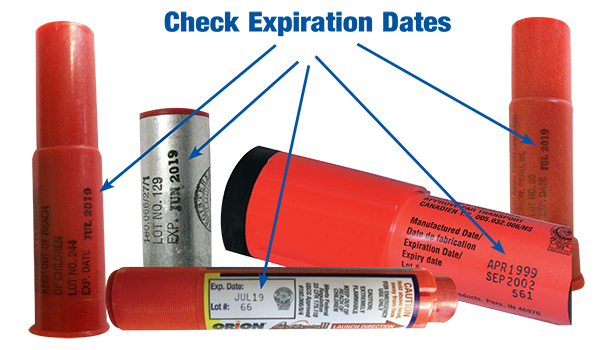USCG FAQ
What are USCG requirements for visual distress signals and where do they apply?
Visual distress signals must be carried on all boats which are operated on the high seas, coastal waters (including the Great Lakes), the territorial seas and all waters directly connected to the Great Lakes or the territorial seas up to a point where the waters are less than two miles wide. See what Safety Experts recommend: Click Here
For more information on USCG requirements, click the links below:
Who is covered by the requirement?
All boats are covered by the requirement if operating on the designated waters at night.
During daytime operation, the following boats do not need to comply with the requirement:
- Recreational boats less than 16 feet in length
- Boats participating in organized events, such as races, regattas, and parades
- Open sailboats not equipped with propulsion machinery and less than 26 feet in length
- Manually propelled boats
My boat never breaks down, why should I comply?
First, pursuant to the Coast Guard regulations, the Coast Guard may impose a civil penalty up to $1,100 for failure to comply with equipment requirements. Second, one never knows when an emergency on the water will occur, whether to you or someone you assist. Risking a fine is one thing; your ability to signal others to a distress situation which could affect you and your family is another.
What types of Visual Distress Signals have been accepted by the Coast Guard?

Red Parachute Flare
Accepted day or night use. Approval Nos. 160.024 (1, 2) 160.036, 160.066 (2, 3)

Red Parachute Flare
Accepted day or night use. Approval Nos. 160.024 (1, 2) 160.036, 160.066 (2, 3)

Red Aerial Flare
Accepted day or night use. Approval Nos. 160.066 (2, 3)

Red Aerial Flare
Accepted day or night use. Approval Nos. 160.066 (2, 3)

Handheld Red Signal Flare
Accepted day or night use. Approval Nos. 160.021 (2)

Handheld Red Signal Flare
Accepted day or night use. Approval Nos. 160.021 (2)

Handheld Orange Smoke Signal
Accepted day use only. Approval Nos. 160.022 (2) 160.037, 160.057

Handheld Orange Smoke Signal
Accepted day use only. Approval Nos. 160.022 (2) 160.037, 160.057

3-Foot Square Orange Distress Flag
Accepted day use only. Approval Nos. 160.072

3-Foot Square Orange Distress Flag
Accepted day use only. Approval Nos. 160.072
Electronic SOS Beacon
Accepted night use only. Approval Nos. 46 CFR 161.013
Electronic SOS Beacon
Accepted night use only. Approval Nos. 46 CFR 161.013
- These signals require use in combination with suitable launching device approved under 46 CFR 160.228
- These signals meet U.S. Coast Guard day/night requirements for 42 months after date of manufacture. They must be replaced before expiration date printed on the label.
- These devices may be either self-contained or pistol launched and either aerial flare or parachute type. Some of these signals may require use in combination with a suitable launching device approved under 46 CFR 160.028.
What types of flares do I need?
There are number of flares that you can use depending on your boating habits. See Orion’s Products Recommendation Guide to find the flares that best meet your needs: Click Here
Since I am covered by the requirement, how many signals do I need to carry?
If you select pyrotechnic signals (including red parachute aerial flares, handheld red signal flares and handheld orange smoke flares) to meet the Coast Guard visual distress signal requirements, a minimum of three must be carried. Any combination of the signals can be carried so long as they add up to three signals for day use and three signals for night use. Remember that while three signals are the legal minimum, search and rescue experts recommend carrying at least six signals onboard.
Will my visual distress signals expire?
Pyrotechnic signaling devices (including aerial flares and handheld signals) expire 42 months after the date of manufacture in accordance with the Coast Guard requirements. Typically, this means that you must replace your flares every three boating seasons.
How do I find expiration dates?
Safe replacement and disposal of pyrotechnic signaling devices begins by checking the expiration date on your product. Pyrotechnic signaling devices (including aerial flares and handheld signals) expire 42 months after the date of manufacture in accordance with the United States Coast Guard requirements. Typically, this means that you must replace your flares every three boating seasons. USCG regulations requires that each pyrotechnic signaling device must be stamped with the expiration date.
Check the expiration dates on your flares and signals as shown below. If they have expired or will expire during the boating season, you must replace them…it’s the law! In addition to printing the expiration date on individual product, Orion also prints the date on all product packaging.

How do I dispose of expired pyrotechnic signals?
To dispose of expired marine pyrotechnic distress signals, Orion recommends the following method:
- Ignite handheld signals flares on land away from regulated waters in a safe area (away from combustible materials, fuel, or fumes), much the same as highway flares would be ignited.
- Contact a local law enforcement or the fire protection agency for their advice on proper visual distress signal disposal.
- Retain flares for back-up use to expand signaling time in the event of an emergency.
- NEVER jettison visual distress signals overboard.
- NEVER activate marine flares in a non-emergency situation on or near regulated water.
- NEVER dispose of flares in household trash.
